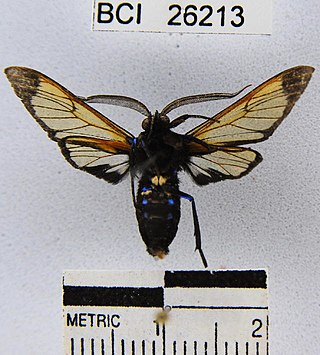
In Gallo-Roman religion, Epona was a protector of horses, ponies, donkeys, and mules. She was particularly a goddess of fertility, as shown by her attributes of a patera, cornucopia, ears of grain, and the presence of foals in some sculptures. She and her horses might also have been leaders of the soul in the after-life ride, with later literary parallels in Rhiannon of the Mabinogion. The worship of Epona, "the sole Celtic divinity ultimately worshipped in Rome itself", as the patroness of cavalry, was widespread in the Roman Empire between the first and third centuries AD; this is unusual for a Celtic deity, most of whom were associated with specific localities.
Agathiphaga is a genus of moths, known as kauri moths. It is the only living in the family Agathiphagidae. This caddisfly-like lineage of primitive moths was first reported by Lionel Jack Dumbleton in 1952, as a new genus of Micropterigidae.

Sarosa is a genus of moths in the subfamily Arctiinae. The genus was erected by Francis Walker in 1854.
Sarosa ozora is a moth of the subfamily Arctiinae. It was described by Herbert Druce in 1883. It is found in Colombia.
Sarosa acutior is a moth in the subfamily Arctiinae. It was described by Felder in 1874. It is found in Ecuador and the Amazon region.
Sarosa notata is a moth in the subfamily Arctiinae. It was described by Arthur Gardiner Butler in 1876. It is found in Colombia and Bolivia.
Sarosa pompilina is a moth in the subfamily Arctiinae. It was described by Arthur Gardiner Butler in 1876. It is found in Panama, Ecuador and the Brazilian state of Espírito Santo.
Sarosa xanthobasis is a moth in the subfamily Arctiinae. It was described by Herbert Druce in 1898. It is found in Ecuador.
Sarosa sesiiformis is a moth in the subfamily Arctiinae. It was described by Francis Walker in 1854. It is found in Venezuela.
Sarosa annotata is a moth in the subfamily Arctiinae. It was described by Paul Dognin in 1914. It is found in Colombia.

Sarosa mora is a moth in the subfamily Arctiinae. It was described by Schaus in 1911. It is found in Costa Rica, Panama and Nicaragua.
Sarosa albraamea is a moth in the subfamily Arctiinae. It was described by Schaus in 1924. It is found in Guyana.
Sarosa atritorna is a moth in the subfamily Arctiinae. It was described by Paul Dognin in 1912. It is found in Colombia.
Sarosa boenninghauseni is a moth in the subfamily Arctiinae. It was described by Rothschild in 1911. It is found in Brazil.

Sarosa connotata is a moth in the subfamily Arctiinae. It was described by George Hampson in 1901. It is found in Peru and Rio de Janeiro, Brazil.
Sarosa flavicostalis is a moth in the subfamily Arctiinae. It was described by Rothschild in 1911. It is found in Peru.
Sarosa ignicornis is a moth in the subfamily Arctiinae. It was described by George Hampson in 1914. It is found in French Guiana.
Sarosa klagesi is a moth in the subfamily Arctiinae. It was described by Rothschild in 1911. It is found in Venezuela.
Sarosa lutibasis is a moth in the subfamily Arctiinae. It was described by George Hampson in 1901. It is found in Panama.
Sarosa pseudohelotes is a moth in the subfamily Arctiinae. It was described by Rothschild in 1931. It is found in Venezuela.


